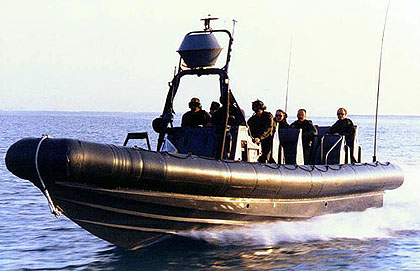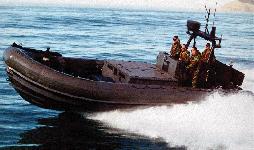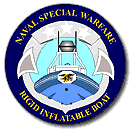







 By 1995 the Special Operations Command (SOC) found the 10 meter Interceptor Fastboats RIB design, on which initial developmental efforts were focused, unsatisfactory and adopted a new strategy for development of a RIB to meet Special Operations Forces requirements. Naval Special Warfare Rigid Inflatable Boat (NSW RIB) performs short-range insertion and extraction of SOF; SOF coastal resupply; and coastal surveillance missions. The rugged, seaworthy, versatile 36-foot RIB has a 200 nautical miles range at 32 knots, with a 45 knot top speed. It can carry eight passengers or 3,200 lbs payload, and is C-130 transportable. Production commenced June 1997, with 70 NSW RIBs funded. The first delivery was November 1997 with an IOC of January 1998. Production is scheduled for FY 1998-2003 by the contractor, U.S. Marine, Inc.; New Orleans, Louisiana. The RIB has a projected 5-year service life.
By 1995 the Special Operations Command (SOC) found the 10 meter Interceptor Fastboats RIB design, on which initial developmental efforts were focused, unsatisfactory and adopted a new strategy for development of a RIB to meet Special Operations Forces requirements. Naval Special Warfare Rigid Inflatable Boat (NSW RIB) performs short-range insertion and extraction of SOF; SOF coastal resupply; and coastal surveillance missions. The rugged, seaworthy, versatile 36-foot RIB has a 200 nautical miles range at 32 knots, with a 45 knot top speed. It can carry eight passengers or 3,200 lbs payload, and is C-130 transportable. Production commenced June 1997, with 70 NSW RIBs funded. The first delivery was November 1997 with an IOC of January 1998. Production is scheduled for FY 1998-2003 by the contractor, U.S. Marine, Inc.; New Orleans, Louisiana. The RIB has a projected 5-year service life.
Early testing was done with close teamwork between OPTEVFOR and the combat users to maximize the perspectives of each. Prototypes from competing vendors were developed and tested all the way to acceptance trials and final source selection. The early testing with contractor prototypes was so operational in nature that the OT&E was completed in the source-selection phase before a production contract was let. The testing was so operationally realistic that normal classical TECHEVAL and OPEVAL were canceled entirely. The NSW RIB testing covered 10,000 nautical miles, in hot and cold, rough and calm extremes, with five SEAL insertion missions, and C-130, C-141, and C-5 flight tests. There were no deficiencies and all operational issues were satisfied.
A highly successful acquisition program, the NSW RIB was delivered to the combat teams in just over two years from program initiation to first unit equipped. The program strategy used commercial boat building experience and practices. The operational requirements of the NSW RIB were all met or exceeded during the combined DT/OT. Top speed exceeded objective by 15 percent (46 kts demonstrated, 40 kts objective); cruise speed exceeded objective by 3 percent (33 kts demonstrated, 32 kts objective); range exceeded objective by 15 percent (200 nm demonstrated, 175 objective); reliability was slightly better (91 percent demonstrated, 90 percent required); and availability exceeded objective by 9 percent (99 percent demonstrated, 90 percent objective).
While it is too early to make final logistical and O&M comparisons of the NSW RIB to the existing boats, reliability has been much better than for the older craft. This leads SOCOM to expect the overall parts and maintenance costs to be lower than for the existing craft. O&M training is performed the same as with the older craft. Preventive maintenance actions are comparable to the older units. The IOC units are exhibiting simplified support and cheaper parts costs due to the COTS components in engines and propulsion systems. Overall the Navy and SOCOM are satisfied enough with the program to be actively considering a reduction of the deployment logistical support kit size for the craft.
Specifications | |
| Builder | U.S. Marine, Inc.; New Orleans, Louisiana |
| Power Plant | |
| Length | 36 feet |
| Beam | feet |
| Draft | feet |
| Displacement | tons |
| Capacity | eight passengers or 3,200 lbs payload |
| Speed | 45 knots |
| Crew | |



